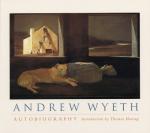
|
| Name: _________________________ | Period: ___________________ |
This test consists of 15 multiple choice questions and 5 short answer questions.
Multiple Choice Questions
1. What piece of furniture is featured in "Front Room" in 1946?
(a) A chair.
(b) A table.
(c) A sofa.
(d) A credenza.
2. What did Wyeth think that light in a painting could do?
(a) Ruin it.
(b) Change the face of a portrait.
(c) Make a picture more saleable.
(d) Shape the meaning of a picture.
3. What does "Spring Beauty" signify for Wyeth's work?
(a) He incorporated people into his paintings.
(b) He began to use watercolors.
(c) He worked on the same vista in each season.
(d) He moves closer to realism.
4. Where did Wyeth find the items for "Before Picking"?
(a) His cornfield.
(b) A commercial orchard.
(c) His backyard.
(d) His father's orchard.
5. Wyeth's emotions were revealed in a dispassionate, _____________ manner from his subjects.
(a) Analytical.
(b) Detached.
(c) Logical.
(d) Engaged.
6. Who was Wyeth's wife?
(a) Sara.
(b) Betty.
(c) Doris.
(d) Maggie.
7. "Christmas Morning" in 1944 was Wyeth's first painting that concerned ________________.
(a) Religion.
(b) Death.
(c) Excess.
(d) Poverty.
8. What did the author say about getting to know Andrew Wyeth?
(a) He never actually met him in person.
(b) They got along famously from the start.
(c) It took him a long time to get to know him as a person.
(d) He never really got comfortable with him.
9. What did Wyeth think that the item in "Toll Rope" represented?
(a) New England as a whole.
(b) Hope.
(c) Religious conviction.
(d) Redemption.
10. For how long had Wyeth been painting at the time this book was written?
(a) 15 years.
(b) 62 years.
(c) 33 years.
(d) 50 years.
11. What did Wyeth think about "Winter Corn" in 1948?
(a) It was his best painting of corn.
(b) It came to him in a dream.
(c) It was almost too depressing to complete.
(d) It was his son's suggestion.
12. In 1933, Wyeth painted "Spring Landscape at _________________".
(a) Kuerners.
(b) Kerwins.
(c) Kerrigans.
(d) Koerners.
13. The author said that Wyeth was no _________________.
(a) Sycophant.
(b) Romantic.
(c) Teacher.
(d) Role model.
14. Which painting follows "Before Picking" in 1942?
(a) The Harvest.
(b) After Picking.
(c) Ripe Rewards.
(d) Autumnal Bliss.
15. Wyeth increasingly experimented with and re-conceptualized _________________.
(a) Pencil sketches.
(b) His use of light.
(c) Portraits.
(d) The use of oils.
Short Answer Questions
1. When did Wyeth cultivate his independence?
2. What did the cooling shed in the painting, "Cooling Shed," remind Wyeth of?
3. "Trodden Weed" in 1951 is a portrait of whose shoes?
4. The painting, "Lobster Traps" was completed when Wyeth was what age?
5. Years after the painting of 1933 was completed, Wyeth sold it to buy __________________.
|
This section contains 398 words (approx. 2 pages at 300 words per page) |

|




